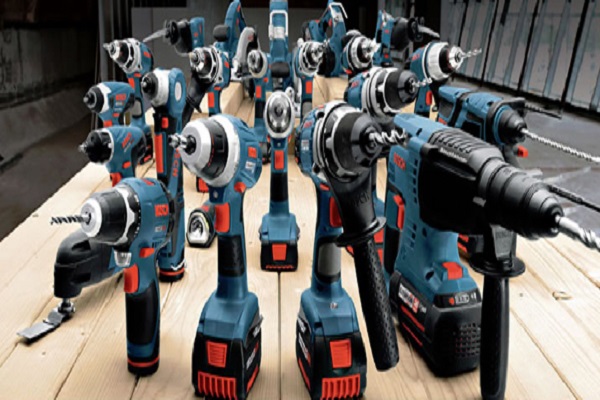Global Electric Power Tools Market has valued at USD 20.08 billion in 2022 and is anticipated to project robust growth in the forecast period with a CAGR of 5.09% through 2028.
The electric power tools market refers to a dynamic and diverse sector of the global economy dedicated to the production, distribution, and sale of a wide range of electrical devices and equipment designed to assist users in performing various tasks and applications across multiple industries. Electric power tools are versatile, handheld or stationary machines powered by electricity, and they are employed for purposes such as cutting, drilling, grinding, sanding, fastening, and shaping materials like wood, metal, and concrete.
This market encompasses a vast array of tools, including but not limited to drills, saws, grinders, sanders, impact drivers, and power screwdrivers, among others. These tools serve both professional users, such as contractors, craftsmen, and industrial workers, and non-professional or DIY enthusiasts who engage in home improvement, repair, and hobbyist activities.
Driven by factors such as technological innovation, industrialization, construction, automotive maintenance, and the burgeoning do-it-yourself (DIY) trend, the electric power tools market continues to evolve. Government policies related to safety, environmental compliance, and energy efficiency also play a significant role in shaping this market. Additionally, the advent of e-commerce has transformed the distribution landscape, making power tools more accessible to consumers worldwide. Overall, the electric power tools market remains a vibrant and essential component of various sectors, facilitating productivity, efficiency, and innovation across industries and user segments.
Key Market Drivers
Industrialization and Infrastructure Development
One of the primary drivers of the global electric power tools market is industrialization and infrastructure development. As countries undergo industrialization and urbanization processes, there is a growing demand for power tools across various sectors, including construction, manufacturing, and energy.
Download FREE Sample Report @ https://www.techsciresearch.com/sample-report.aspx?cid=16980
In the construction industry, electric power tools such as drills, saws, and concrete mixers are essential for tasks like drilling, cutting, and concrete work. With urban populations on the rise, there is a continuous need for residential and commercial buildings, roads, bridges, and other infrastructure projects. This sustained construction activity fuels the demand for electric power tools.
Infrastructure development also extends to sectors like energy generation and transmission. Power plants, renewable energy installations, and electrical grid expansion projects require power tools for installation, maintenance, and repair. The growth of renewable energy sources, in particular, has created opportunities for electric power tool manufacturers as wind turbines, solar panels, and battery storage systems become more prevalent.
As developing and emerging economies invest in building and upgrading their infrastructure, the electric power tools market benefits from the increasing demand for high-quality, reliable tools. Manufacturers are continually innovating to meet the specific needs of these industries, driving growth in the market.
DIY and Home Improvement Trends
The global electric power tools market is experiencing significant growth due to the increasing popularity of do-it-yourself (DIY) and home improvement projects. A combination of factors, including the availability of information online, changing consumer lifestyles, and the desire to personalize living spaces, is driving this trend.
Consumers are increasingly turning to DIY projects for various reasons, including cost savings and a sense of accomplishment. Electric power tools are essential for tasks such as woodworking, home renovation, landscaping, and crafting. These tools empower individuals to take on a wide range of projects, from building custom furniture to installing energy-efficient appliances.
Online platforms, including video tutorials and social media, have made it easier than ever for people to access DIY guides and inspiration. Consumers can find step-by-step instructions and ideas for home improvement projects, encouraging them to invest in electric power tools to achieve their goals.
The COVID-19 pandemic also accelerated the DIY trend, as more people spent time at home and sought ways to enhance their living spaces. Home offices, outdoor entertainment areas, and home gyms became popular projects, all of which often require electric power tools for construction and customization.
Manufacturers in the electric power tools market are responding to this trend by designing user-friendly tools with ergonomic features, improved safety mechanisms, and easy-to-follow instructions. They are also expanding their product lines to cater to the specific needs of DIY enthusiasts, further driving market growth.
Technological Advancements and Innovation
Technological advancements and innovation are key drivers of the global electric power tools market. Manufacturers are constantly investing in research and development to introduce cutting-edge technologies and features that enhance the performance, efficiency, and safety of electric power tools.
Some notable technological advancements driving the market include:
- Brushless Motors: Brushless motor technology offers higher efficiency, longer lifespan, and reduced maintenance compared to traditional brushed motors. Electric power tools equipped with brushless motors deliver better performance and longer runtime.
- Lithium-Ion Batteries: The transition from nickel-cadmium (NiCd) batteries to lithium-ion (Li-ion) batteries has revolutionized the industry. Li-ion batteries offer higher energy density, faster charging times, and longer-lasting power, making electric power tools more convenient and efficient.
- Smart Features: Electric power tools with smart features, such as Bluetooth connectivity and mobile app compatibility, provide users with real-time data, remote control, and customization options. These features enhance user experience and tool performance.
- Improved Safety Mechanisms: Innovations in safety mechanisms, including electronic braking systems, kickback reduction, and anti-vibration technologies, contribute to safer tool operation, reducing the risk of accidents and injuries.
- Ergonomic Design: Manufacturers are focusing on ergonomic designs to enhance user comfort during prolonged tool use. Ergonomically designed handles, grips, and weight distribution contribute to reduced user fatigue.
- Environmental Sustainability: Sustainability is a growing trend, and manufacturers are developing electric power tools with reduced environmental impact. This includes using eco-friendly materials and designing tools for longevity and recyclability.
These technological advancements not only attract professional users seeking higher productivity but also appeal to DIY enthusiasts looking for convenience and ease of use. As manufacturers continue to innovate and introduce new features, the electric power tools market remains dynamic and competitive.
Growth in the Automotive Industry
The growth of the global automotive industry is a significant driver of the electric power tools market. Electric power tools play a crucial role in automotive manufacturing, assembly, maintenance, and repair processes, making them indispensable for both original equipment manufacturers (OEMs) and repair shops.
Several factors contribute to the automotive industry’s impact on the electric power tools market:
- Manufacturing and Assembly: Electric power tools are essential in the manufacturing and assembly of vehicles. They are used for tasks such as welding, fastening, painting, and bodywork. As the automotive industry experiences growth and diversification, the demand for power tools continues to rise.
- Maintenance and Repair: Automotive repair shops rely heavily on electric power tools for servicing vehicles. From engine diagnostics to brake repairs, power tools enable mechanics to perform tasks efficiently and accurately. The increasing number of vehicles on the road drives ongoing demand for repair and maintenance services, leading to a steady demand for power tools.
- Technological Advancements: Advancements in electric power tool technology, such as high-torque motors and precision control systems, have enabled automotive professionals to work more efficiently and with greater precision. These tools contribute to the overall quality and reliability of automotive work.
- Electric and Hybrid Vehicles: The growth of electric and hybrid vehicles presents new opportunities for electric power tool manufacturers. Electric and hybrid vehicles require specialized tools for servicing their unique components, such as high-voltage systems and battery packs.
The automotive industry’s expansion, coupled with the need for advanced and specialized electric power tools, ensures a consistent and robust demand for these tools. Manufacturers in this market segment are continuously developing tools tailored to the specific needs of the automotive sector, further driving market growth.
Renewable Energy and Green Technologies
The increasing focus on renewable energy sources and green technologies is a significant driver of the global electric power tools market. The transition to cleaner and more sustainable energy generation and storage methods has created new opportunities for power tools, particularly in the installation, maintenance, and servicing of renewable energy systems.
Several key factors contribute to the impact of renewable energy and green technologies on the electric power tools market:
- Solar Power: Solar panel installation and maintenance require electric power tools for tasks such as drilling, fastening, and wiring. As solar energy adoption grows, the demand for power tools in the solar industry also increases.
- Wind Energy: The wind turbine industry relies on electric power tools for installation and maintenance tasks, including tower assembly, blade repair, and electrical connections. Wind farms, both onshore and offshore, create ongoing demand for power tools.
- Battery Storage: The growth of battery energy storage systems, used for grid stabilization and energy storage, requires electric power tools for installation and maintenance. These tools are essential for handling high-capacity batteries and electrical components.
- Energy Efficiency Retrofits: As energy efficiency becomes a priority, power tools are needed for retrofitting buildings and industrial facilities with green technologies. These retrofits include energy-efficient lighting, HVAC systems, and insulation installations.
- Environmental Concerns: The environmental impact of power tools, such as emissions and noise pollution, is a focus for manufacturers. Eco-friendly electric power tools designed for sustainable use are in higher demand.
The drive toward renewable energy and green technologies aligns with global sustainability goals and government incentives for clean energy adoption. Electric power tool manufacturers are responding by developing specialized tools and equipment tailored to the needs of the renewable energy sector, creating a niche market within the industry.
E-Commerce and Online Retail
The growth of e-commerce and online retail channels is a significant driver of the global electric power tools market. The convenience and accessibility of online shopping have transformed the way consumers purchase power tools, influencing market dynamics and distribution strategies.
Several key factors illustrate the impact of e-commerce and online retail on the electric power tools market:
- Wide Product Selection: Online platforms offer consumers a vast selection of electric power tools from various manufacturers and brands. This extensive product range allows consumers to compare features, prices, and customer reviews, enabling informed purchasing decisions.
- Convenience: E-commerce provides consumers with the convenience of shopping for power tools from the comfort of their homes or workplaces. They can browse, research, and make purchases 24/7, eliminating the need to visit physical stores.
- Price Transparency: Online retail platforms often display price comparisons and discounts, allowing consumers to find the best deals. Price transparency contributes to competitive pricing and increased affordability.
- Customer Reviews and Ratings: Online platforms feature customer reviews and ratings that provide valuable insights into the performance and reliability of electric power tools. This information helps consumers make informed choices.
- Global Access: Consumers can access a global marketplace of electric power tools, making it possible to purchase tools not available locally. This opens up opportunities for manufacturers to reach international customers.
- Direct Sales and Marketplaces: Manufacturers can sell directly to consumers through their websites or participate in online marketplaces, expanding their reach and streamlining distribution.
To remain competitive in the digital age, electric power tool manufacturers are enhancing their online presence, optimizing e-commerce platforms, and focusing on digital marketing strategies. E-commerce has become a driving force behind the accessibility, availability, and growth of the electric power tools market, catering to a diverse and global customer base..
Government Policies are Likely to Propel the Market
Energy Efficiency Standards and Labels
Energy efficiency standards and labeling policies are crucial government initiatives in the global electric power tools market. These policies aim to reduce energy consumption, promote sustainability, and guide consumers in making informed choices when purchasing power tools.
Energy efficiency standards set minimum performance requirements that electric power tools must meet to be sold in a particular market. These standards typically focus on power tools’ energy consumption during operation. Manufacturers are required to design and produce tools that meet or exceed these efficiency standards, ensuring that the tools perform their intended functions while using energy efficiently.
In addition to standards, governments often implement labeling programs that provide consumers with information about a power tool’s energy efficiency. Energy labels display important metrics, such as power consumption, efficiency ratings, and estimated energy costs. These labels help consumers compare different power tools and make informed decisions based on their energy efficiency requirements and budget constraints.
Energy efficiency policies benefit both consumers and the environment. Consumers can choose power tools that reduce their energy bills while contributing to a decrease in greenhouse gas emissions. Manufacturers are encouraged to innovate and produce more energy-efficient tools, driving technological advancements in the industry.
Furthermore, these policies align with global efforts to combat climate change and promote sustainable practices. Governments worldwide continue to strengthen energy efficiency standards and labeling requirements to foster a more sustainable electric power tools market.
Environmental Regulations and Product Compliance
Environmental regulations and product compliance policies are essential in the global electric power tools market to address concerns related to hazardous materials, electronic waste (e-waste), and product disposal. Governments establish and enforce these policies to protect the environment and human health.
One key aspect of environmental regulations is the restriction of hazardous substances in electric power tools. Regulations, such as the European Union’s Restriction of Hazardous Substances (RoHS) directive, limit the use of harmful materials like lead, mercury, and cadmium in the manufacturing of power tools. Compliance with these regulations ensures that power tools are safe for use and disposal.
Product compliance policies also encompass safety standards and certifications that electric power tools must meet before entering the market. These standards cover aspects such as electrical safety, mechanical safety, and ergonomic design. Manufacturers must conduct testing and obtain certification to demonstrate compliance with these regulations, which varies from one region to another.
Environmental compliance extends to the disposal of electric power tools at the end of their lifecycle. Governments encourage responsible disposal practices, such as recycling and proper e-waste management, to minimize the environmental impact of discarded tools. Manufacturers are often required to take back and recycle their products, ensuring that e-waste is handled safely and sustainably.
Additionally, governments may implement extended producer responsibility (EPR) programs, where manufacturers are responsible for managing the collection, recycling, and disposal of their products. These programs incentivize manufacturers to design products with end-of-life considerations, promoting the development of eco-friendly and recyclable power tools.
Environmental regulations and product compliance policies play a critical role in promoting sustainable practices within the electric power tools market. By reducing the use of hazardous materials, improving product safety, and managing e-waste, these policies contribute to a cleaner and more environmentally responsible industry.
Trade Tariffs and Import Regulations
Trade tariffs and import regulations significantly influence the global electric power tools market by affecting pricing, market access, and trade flows. These government policies are crucial considerations for both manufacturers and consumers in the industry.
Trade Tariffs:
- Impact on Pricing: Tariffs, which are taxes imposed on imported goods, can significantly impact the pricing of electric power tools. Higher tariffs increase the cost of imported tools, potentially leading to higher retail prices for consumers. Conversely, lower tariffs or trade agreements can make imported tools more affordable.
- Market Access: Tariffs can also affect market access for manufacturers. High tariffs may deter foreign manufacturers from entering a market, while low tariffs can encourage competition and provide consumers with a wider range of product choices.
- Global Trade Flows: Tariffs can influence the flow of electric power tools in global trade. Trade tensions or disputes between countries can lead to the imposition of tariffs, disrupting the supply chain and potentially causing price fluctuations and shortages.
Import Regulations:
- Product Safety and Standards: Governments often have import regulations that require electric power tools to meet specific safety and quality standards before entering the market. These regulations are designed to protect consumers from substandard or unsafe products.
- Certification and Compliance: Import regulations may require manufacturers to obtain certifications or conduct testing to demonstrate product compliance with local standards. Compliance can involve additional costs and administrative requirements for manufacturers.
- Customs and Documentation: Importing electric power tools often requires adherence to customs procedures and documentation, which can be complex and time-consuming. Failure to comply with these requirements can result in delays and additional costs.
To navigate the challenges posed by trade tariffs and import regulations, manufacturers must stay informed about trade policies in different markets and adjust their strategies accordingly. For consumers, understanding the impact of tariffs on pricing and product availability can help make informed purchasing decisions.
Research and Development Incentives
Government policies that incentivize research and development (R&D) play a critical role in driving innovation and technological advancement in the global electric power tools market. These policies aim to stimulate investments in R&D, leading to the development of cutting-edge tools with improved performance, efficiency, and safety features.
Incentives for R&D can take various forms, including tax credits, grants, subsidies, and partnerships between government agencies and private sector organizations. These incentives encourage manufacturers to allocate resources to research projects that enhance the quality and functionality of electric power tools.
Key aspects of government R&D incentives in the electric power tools market include:
- Technological Advancement: Manufacturers are motivated to invest in research that leads to breakthroughs in power tool technology. This can result in the development of more energy-efficient tools, innovative safety features, and improved ergonomics.
- Competitive Advantage: Companies that engage in R&D and produce innovative power tools gain a competitive advantage in the market. They can offer products that stand out in terms of performance, reliability, and user experience.
- Market Differentiation: Government-supported R&D can enable manufacturers to differentiate their products in a crowded marketplace. Unique features and cutting-edge technologies can attract consumers seeking the latest advancements.
- Sustainability: R&D incentives can also drive research into eco-friendly power tools with reduced environmental impact. This aligns with global sustainability goals and regulatory requirements.
- Collaboration: Governments may encourage collaboration between manufacturers, research institutions, and academia to foster knowledge sharing and collaborative R&D projects. These partnerships can accelerate innovation.
Government-supported R&D initiatives benefit not only manufacturers but also consumers by delivering products that are safer, more efficient, and more technologically advanced. Additionally, they contribute to the growth and competitiveness of the electric power tools market on a global scale.
Intellectual Property Protection and Patent Laws
Intellectual property (IP) protection and patent laws are instrumental government policies that impact innovation, competition, and market dynamics in the global electric power tools market. These policies safeguard the rights of inventors and innovators, fostering investment in research and development.
Key aspects of government IP and patent policies in the electric power tools market include:
- Patent Protection: Patent laws grant inventors exclusive rights to their innovations for a specified period, allowing them to prevent others from making, using, selling, or importing their patented inventions. This incentivizes manufacturers to invest in R&D and protect their proprietary technologies.
- Innovation Incentives: IP protection encourages power tool manufacturers to develop unique and inventive features, technologies, and designs. This leads to a continuous stream of new and improved products in the market.
- Market Competition: While patents provide inventors with exclusive rights, they also introduce competition among manufacturers to develop alternative solutions. This competition drives the industry forward and benefits consumers by offering a variety of innovative options.
- Product Differentiation: Manufacturers can use their patented technologies to differentiate their products from competitors. This differentiation can include unique safety features, ergonomic designs, or innovative functionalities.
- Collaboration and Licensing: Patent holders may engage in licensing agreements or collaborations with other companies to share technologies and generate additional revenue streams.
- Enforcement: Governments and legal systems play a role in enforcing patent rights. This involves addressing patent infringements and protecting inventors’ intellectual property.
Balancing IP protection with competition is a complex challenge. Governments must strike a balance that encourages innovation while preventing anti-competitive practices or monopolistic control over the electric power tools market.
For manufacturers, understanding the importance of IP protection, securing patents for valuable innovations, and respecting the intellectual property rights of others are key considerations for success in the industry.
Occupational Safety and Health Regulations
Occupational safety and health regulations are critical government policies in the global electric power tools market. These policies are designed to protect the well-being of workers who use power tools in various industries, including construction, manufacturing, and maintenance.
Key aspects of government occupational safety and health regulations in the electric power tools market include:
- Safety Standards: Governments establish safety standards that electric power tools must meet to ensure their safe operation. These standards cover aspects such as electrical safety, mechanical safety, ergonomic design, and the inclusion of safety features.
- Training and Certification: Many governments require workers to undergo training and obtain certification to use power tools safely. Training programs typically include instruction on tool operation, maintenance, and safety precautions.
- Employer Responsibilities: Employers are responsible for providing safe working conditions and ensuring that workers have access to appropriate personal protective equipment (PPE) when using power tools. Employers must also implement safety protocols and procedures.
- Inspections and Audits: Government agencies conduct inspections and audits to ensure that employers comply with safety regulations. Non-compliance can result in fines and legal consequences.
- Incentives and Penalties: Some governments provide incentives, such as tax credits or reduced insurance premiums, to employers who prioritize worker safety and invest in safer power tools. Conversely, penalties may be imposed on employers found in violation of safety regulations.
Occupational safety and health regulations are instrumental in mitigating the risks associated with power tool use in various industries. They protect workers from accidents and injuries, promote safer work environments, and ensure that employers and employees adhere to safety best practices.
Manufacturers of electric power tools also play a role by designing tools with safety features, providing clear user instructions, and supporting safety initiatives in the workplace. These efforts contribute to the overall effectiveness of government occupational safety and health policies in the electric power tools market.
Related Reports
Power Tools Market [2028]: Analysis & Forecast
Solar Control Window Films Market [2028]: Analysis & Forecast
Light Gauge Steel Framing Market – [2028] Growth, Trends & Forecast




